Organisation Behaviour Report: Motivation and Culture in Business
VerifiedAdded on 2022/11/12
|10
|2519
|390
Report
AI Summary
This report delves into the core concepts of organisational behaviour, examining the critical roles of motivation and engagement within an organisation. It explores how individual characteristics and workplace environments influence employee behaviour and organizational outcomes. The report discusses key theories such as Herzberg's two-factor theory, and expectancy theory to explain motivation, and the impact of organizational culture on employee interaction and business performance. Furthermore, the report highlights the interconnectedness of organizational culture and change, emphasizing how a positive culture can foster employee engagement, innovation, and overall organizational success. The analysis includes the association of motivation and engagement with organizational culture and change, providing insights into how to improve organizational functioning and employee management. The report also highlights the importance of flexible working environments and continuous skill development for maintaining employee well-being and motivation.
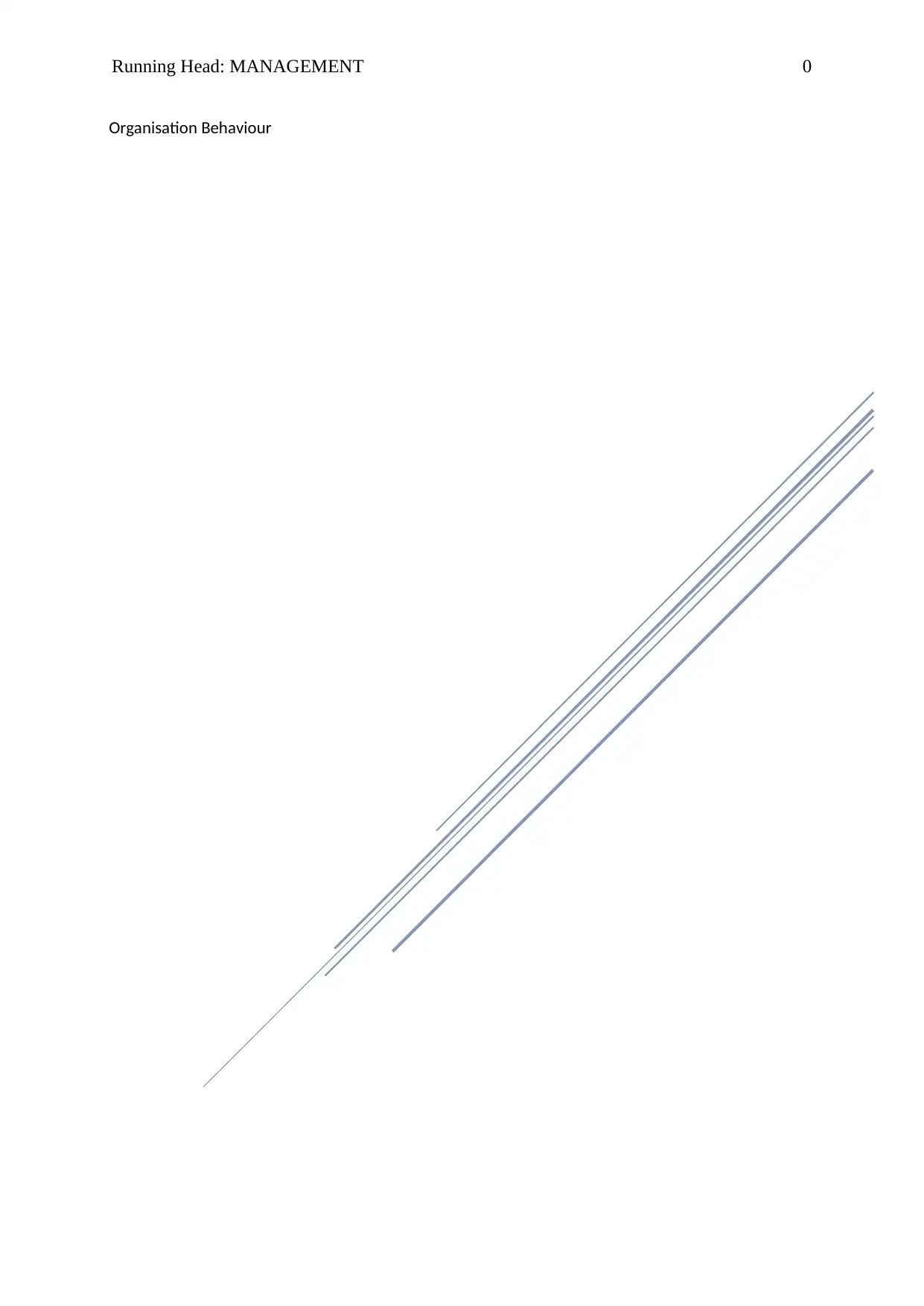
Running Head: MANAGEMENT 0
Organisation Behaviour
Organisation Behaviour
Paraphrase This Document
Need a fresh take? Get an instant paraphrase of this document with our AI Paraphraser
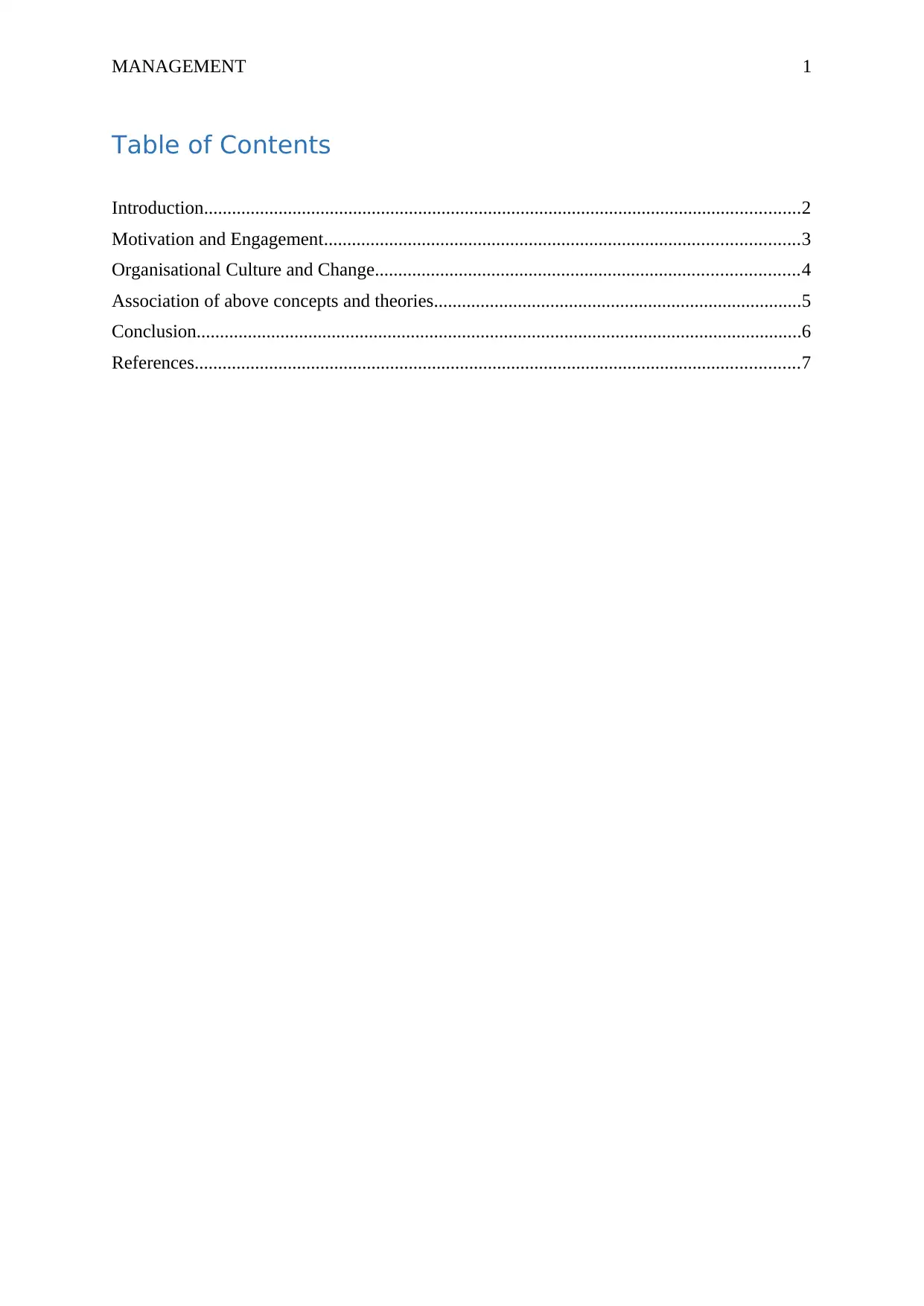
MANAGEMENT 1
Table of Contents
Introduction................................................................................................................................2
Motivation and Engagement......................................................................................................3
Organisational Culture and Change...........................................................................................4
Association of above concepts and theories...............................................................................5
Conclusion..................................................................................................................................6
References..................................................................................................................................7
Table of Contents
Introduction................................................................................................................................2
Motivation and Engagement......................................................................................................3
Organisational Culture and Change...........................................................................................4
Association of above concepts and theories...............................................................................5
Conclusion..................................................................................................................................6
References..................................................................................................................................7
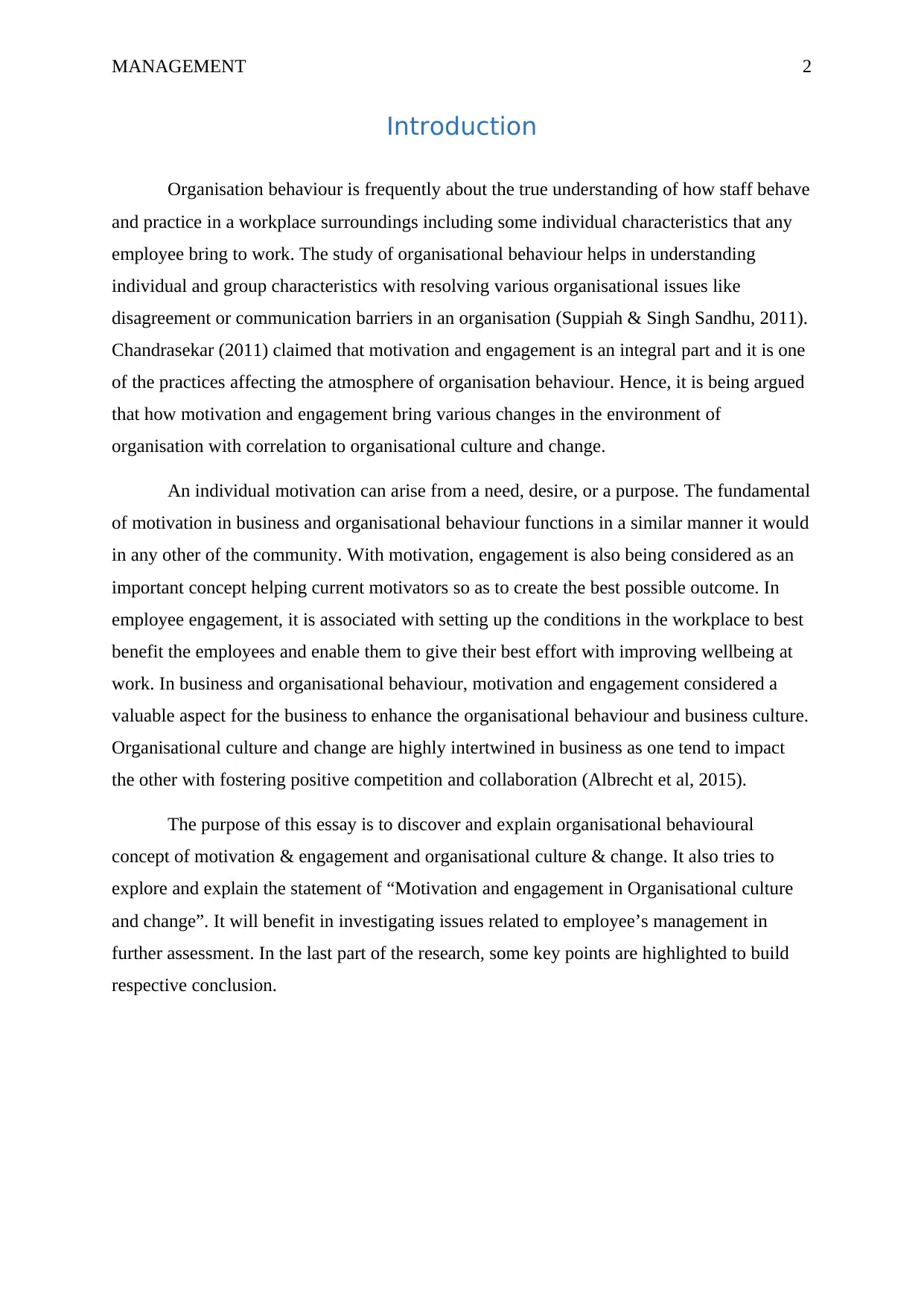
MANAGEMENT 2
Introduction
Organisation behaviour is frequently about the true understanding of how staff behave
and practice in a workplace surroundings including some individual characteristics that any
employee bring to work. The study of organisational behaviour helps in understanding
individual and group characteristics with resolving various organisational issues like
disagreement or communication barriers in an organisation (Suppiah & Singh Sandhu, 2011).
Chandrasekar (2011) claimed that motivation and engagement is an integral part and it is one
of the practices affecting the atmosphere of organisation behaviour. Hence, it is being argued
that how motivation and engagement bring various changes in the environment of
organisation with correlation to organisational culture and change.
An individual motivation can arise from a need, desire, or a purpose. The fundamental
of motivation in business and organisational behaviour functions in a similar manner it would
in any other of the community. With motivation, engagement is also being considered as an
important concept helping current motivators so as to create the best possible outcome. In
employee engagement, it is associated with setting up the conditions in the workplace to best
benefit the employees and enable them to give their best effort with improving wellbeing at
work. In business and organisational behaviour, motivation and engagement considered a
valuable aspect for the business to enhance the organisational behaviour and business culture.
Organisational culture and change are highly intertwined in business as one tend to impact
the other with fostering positive competition and collaboration (Albrecht et al, 2015).
The purpose of this essay is to discover and explain organisational behavioural
concept of motivation & engagement and organisational culture & change. It also tries to
explore and explain the statement of “Motivation and engagement in Organisational culture
and change”. It will benefit in investigating issues related to employee’s management in
further assessment. In the last part of the research, some key points are highlighted to build
respective conclusion.
Introduction
Organisation behaviour is frequently about the true understanding of how staff behave
and practice in a workplace surroundings including some individual characteristics that any
employee bring to work. The study of organisational behaviour helps in understanding
individual and group characteristics with resolving various organisational issues like
disagreement or communication barriers in an organisation (Suppiah & Singh Sandhu, 2011).
Chandrasekar (2011) claimed that motivation and engagement is an integral part and it is one
of the practices affecting the atmosphere of organisation behaviour. Hence, it is being argued
that how motivation and engagement bring various changes in the environment of
organisation with correlation to organisational culture and change.
An individual motivation can arise from a need, desire, or a purpose. The fundamental
of motivation in business and organisational behaviour functions in a similar manner it would
in any other of the community. With motivation, engagement is also being considered as an
important concept helping current motivators so as to create the best possible outcome. In
employee engagement, it is associated with setting up the conditions in the workplace to best
benefit the employees and enable them to give their best effort with improving wellbeing at
work. In business and organisational behaviour, motivation and engagement considered a
valuable aspect for the business to enhance the organisational behaviour and business culture.
Organisational culture and change are highly intertwined in business as one tend to impact
the other with fostering positive competition and collaboration (Albrecht et al, 2015).
The purpose of this essay is to discover and explain organisational behavioural
concept of motivation & engagement and organisational culture & change. It also tries to
explore and explain the statement of “Motivation and engagement in Organisational culture
and change”. It will benefit in investigating issues related to employee’s management in
further assessment. In the last part of the research, some key points are highlighted to build
respective conclusion.
⊘ This is a preview!⊘
Do you want full access?
Subscribe today to unlock all pages.

Trusted by 1+ million students worldwide
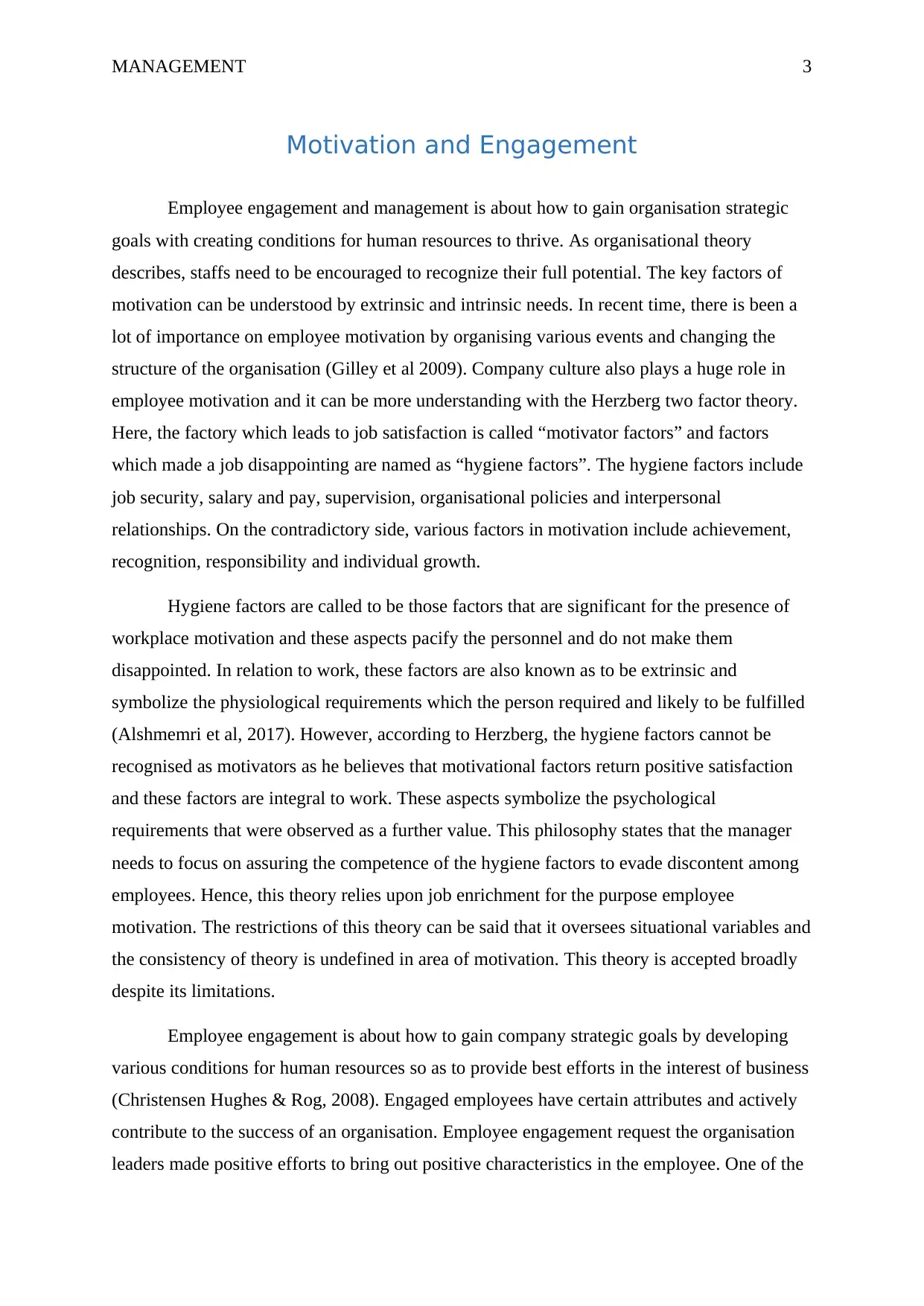
MANAGEMENT 3
Motivation and Engagement
Employee engagement and management is about how to gain organisation strategic
goals with creating conditions for human resources to thrive. As organisational theory
describes, staffs need to be encouraged to recognize their full potential. The key factors of
motivation can be understood by extrinsic and intrinsic needs. In recent time, there is been a
lot of importance on employee motivation by organising various events and changing the
structure of the organisation (Gilley et al 2009). Company culture also plays a huge role in
employee motivation and it can be more understanding with the Herzberg two factor theory.
Here, the factory which leads to job satisfaction is called “motivator factors” and factors
which made a job disappointing are named as “hygiene factors”. The hygiene factors include
job security, salary and pay, supervision, organisational policies and interpersonal
relationships. On the contradictory side, various factors in motivation include achievement,
recognition, responsibility and individual growth.
Hygiene factors are called to be those factors that are significant for the presence of
workplace motivation and these aspects pacify the personnel and do not make them
disappointed. In relation to work, these factors are also known as to be extrinsic and
symbolize the physiological requirements which the person required and likely to be fulfilled
(Alshmemri et al, 2017). However, according to Herzberg, the hygiene factors cannot be
recognised as motivators as he believes that motivational factors return positive satisfaction
and these factors are integral to work. These aspects symbolize the psychological
requirements that were observed as a further value. This philosophy states that the manager
needs to focus on assuring the competence of the hygiene factors to evade discontent among
employees. Hence, this theory relies upon job enrichment for the purpose employee
motivation. The restrictions of this theory can be said that it oversees situational variables and
the consistency of theory is undefined in area of motivation. This theory is accepted broadly
despite its limitations.
Employee engagement is about how to gain company strategic goals by developing
various conditions for human resources so as to provide best efforts in the interest of business
(Christensen Hughes & Rog, 2008). Engaged employees have certain attributes and actively
contribute to the success of an organisation. Employee engagement request the organisation
leaders made positive efforts to bring out positive characteristics in the employee. One of the
Motivation and Engagement
Employee engagement and management is about how to gain organisation strategic
goals with creating conditions for human resources to thrive. As organisational theory
describes, staffs need to be encouraged to recognize their full potential. The key factors of
motivation can be understood by extrinsic and intrinsic needs. In recent time, there is been a
lot of importance on employee motivation by organising various events and changing the
structure of the organisation (Gilley et al 2009). Company culture also plays a huge role in
employee motivation and it can be more understanding with the Herzberg two factor theory.
Here, the factory which leads to job satisfaction is called “motivator factors” and factors
which made a job disappointing are named as “hygiene factors”. The hygiene factors include
job security, salary and pay, supervision, organisational policies and interpersonal
relationships. On the contradictory side, various factors in motivation include achievement,
recognition, responsibility and individual growth.
Hygiene factors are called to be those factors that are significant for the presence of
workplace motivation and these aspects pacify the personnel and do not make them
disappointed. In relation to work, these factors are also known as to be extrinsic and
symbolize the physiological requirements which the person required and likely to be fulfilled
(Alshmemri et al, 2017). However, according to Herzberg, the hygiene factors cannot be
recognised as motivators as he believes that motivational factors return positive satisfaction
and these factors are integral to work. These aspects symbolize the psychological
requirements that were observed as a further value. This philosophy states that the manager
needs to focus on assuring the competence of the hygiene factors to evade discontent among
employees. Hence, this theory relies upon job enrichment for the purpose employee
motivation. The restrictions of this theory can be said that it oversees situational variables and
the consistency of theory is undefined in area of motivation. This theory is accepted broadly
despite its limitations.
Employee engagement is about how to gain company strategic goals by developing
various conditions for human resources so as to provide best efforts in the interest of business
(Christensen Hughes & Rog, 2008). Engaged employees have certain attributes and actively
contribute to the success of an organisation. Employee engagement request the organisation
leaders made positive efforts to bring out positive characteristics in the employee. One of the
Paraphrase This Document
Need a fresh take? Get an instant paraphrase of this document with our AI Paraphraser
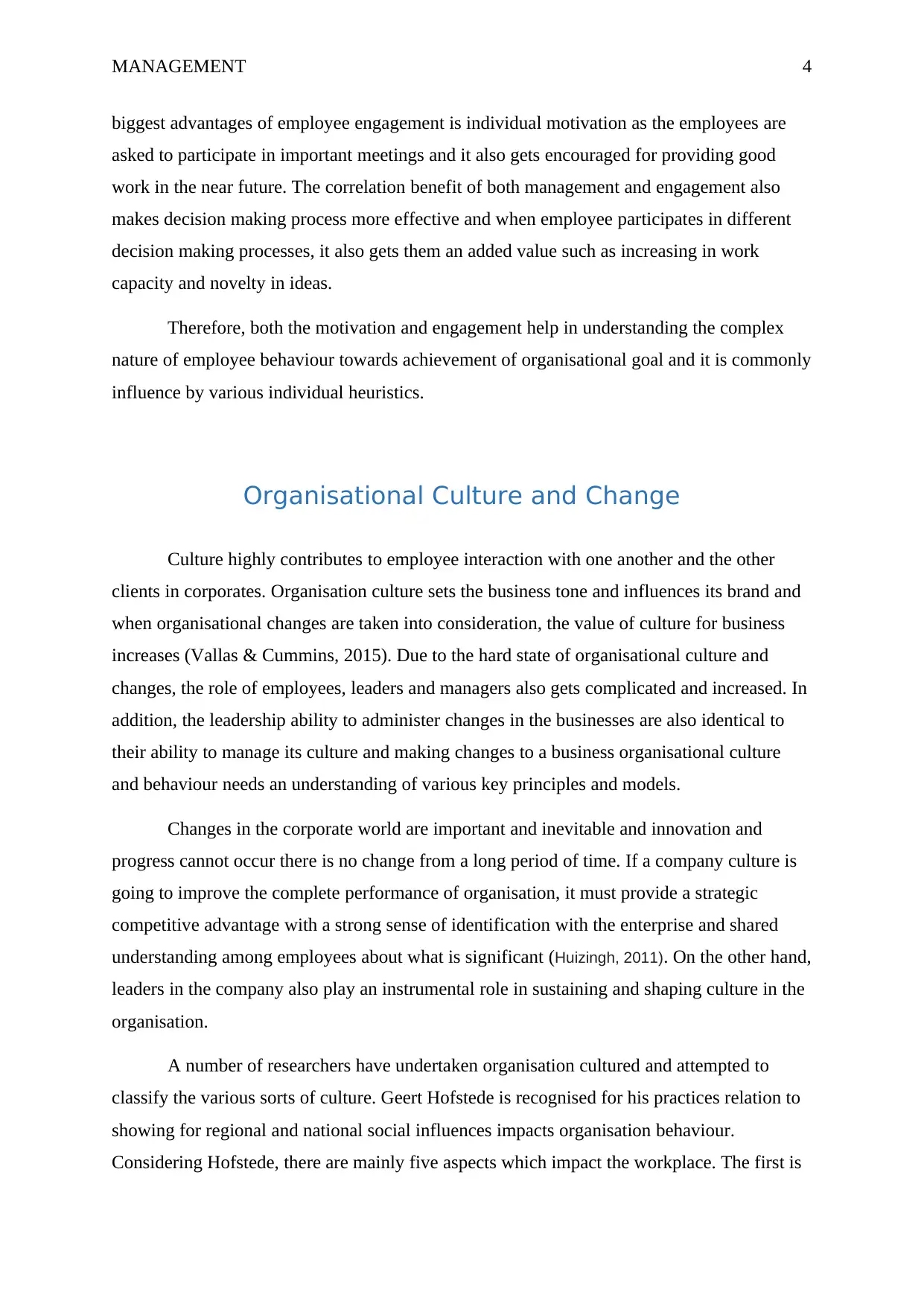
MANAGEMENT 4
biggest advantages of employee engagement is individual motivation as the employees are
asked to participate in important meetings and it also gets encouraged for providing good
work in the near future. The correlation benefit of both management and engagement also
makes decision making process more effective and when employee participates in different
decision making processes, it also gets them an added value such as increasing in work
capacity and novelty in ideas.
Therefore, both the motivation and engagement help in understanding the complex
nature of employee behaviour towards achievement of organisational goal and it is commonly
influence by various individual heuristics.
Organisational Culture and Change
Culture highly contributes to employee interaction with one another and the other
clients in corporates. Organisation culture sets the business tone and influences its brand and
when organisational changes are taken into consideration, the value of culture for business
increases (Vallas & Cummins, 2015). Due to the hard state of organisational culture and
changes, the role of employees, leaders and managers also gets complicated and increased. In
addition, the leadership ability to administer changes in the businesses are also identical to
their ability to manage its culture and making changes to a business organisational culture
and behaviour needs an understanding of various key principles and models.
Changes in the corporate world are important and inevitable and innovation and
progress cannot occur there is no change from a long period of time. If a company culture is
going to improve the complete performance of organisation, it must provide a strategic
competitive advantage with a strong sense of identification with the enterprise and shared
understanding among employees about what is significant (Huizingh, 2011). On the other hand,
leaders in the company also play an instrumental role in sustaining and shaping culture in the
organisation.
A number of researchers have undertaken organisation cultured and attempted to
classify the various sorts of culture. Geert Hofstede is recognised for his practices relation to
showing for regional and national social influences impacts organisation behaviour.
Considering Hofstede, there are mainly five aspects which impact the workplace. The first is
biggest advantages of employee engagement is individual motivation as the employees are
asked to participate in important meetings and it also gets encouraged for providing good
work in the near future. The correlation benefit of both management and engagement also
makes decision making process more effective and when employee participates in different
decision making processes, it also gets them an added value such as increasing in work
capacity and novelty in ideas.
Therefore, both the motivation and engagement help in understanding the complex
nature of employee behaviour towards achievement of organisational goal and it is commonly
influence by various individual heuristics.
Organisational Culture and Change
Culture highly contributes to employee interaction with one another and the other
clients in corporates. Organisation culture sets the business tone and influences its brand and
when organisational changes are taken into consideration, the value of culture for business
increases (Vallas & Cummins, 2015). Due to the hard state of organisational culture and
changes, the role of employees, leaders and managers also gets complicated and increased. In
addition, the leadership ability to administer changes in the businesses are also identical to
their ability to manage its culture and making changes to a business organisational culture
and behaviour needs an understanding of various key principles and models.
Changes in the corporate world are important and inevitable and innovation and
progress cannot occur there is no change from a long period of time. If a company culture is
going to improve the complete performance of organisation, it must provide a strategic
competitive advantage with a strong sense of identification with the enterprise and shared
understanding among employees about what is significant (Huizingh, 2011). On the other hand,
leaders in the company also play an instrumental role in sustaining and shaping culture in the
organisation.
A number of researchers have undertaken organisation cultured and attempted to
classify the various sorts of culture. Geert Hofstede is recognised for his practices relation to
showing for regional and national social influences impacts organisation behaviour.
Considering Hofstede, there are mainly five aspects which impact the workplace. The first is
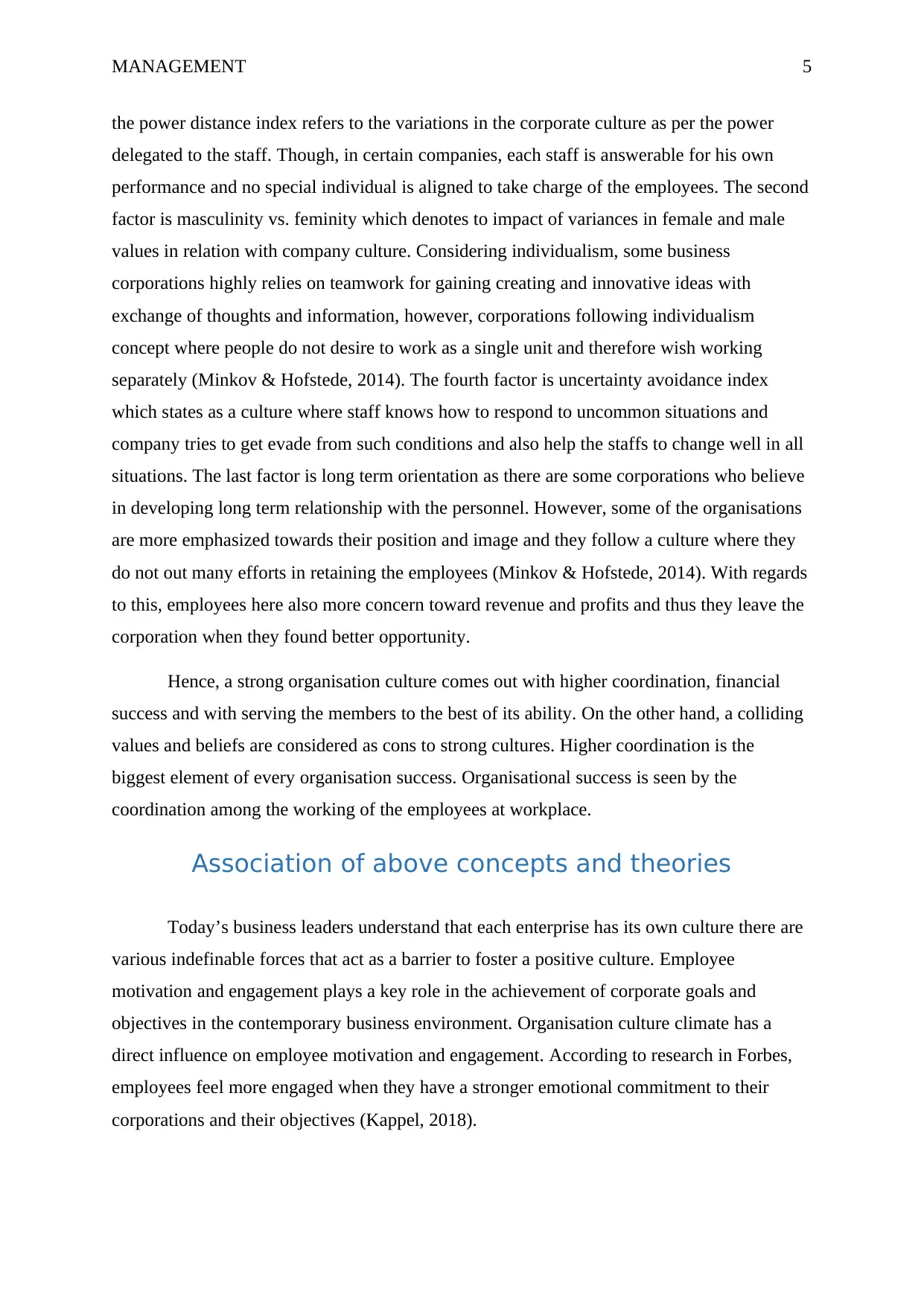
MANAGEMENT 5
the power distance index refers to the variations in the corporate culture as per the power
delegated to the staff. Though, in certain companies, each staff is answerable for his own
performance and no special individual is aligned to take charge of the employees. The second
factor is masculinity vs. feminity which denotes to impact of variances in female and male
values in relation with company culture. Considering individualism, some business
corporations highly relies on teamwork for gaining creating and innovative ideas with
exchange of thoughts and information, however, corporations following individualism
concept where people do not desire to work as a single unit and therefore wish working
separately (Minkov & Hofstede, 2014). The fourth factor is uncertainty avoidance index
which states as a culture where staff knows how to respond to uncommon situations and
company tries to get evade from such conditions and also help the staffs to change well in all
situations. The last factor is long term orientation as there are some corporations who believe
in developing long term relationship with the personnel. However, some of the organisations
are more emphasized towards their position and image and they follow a culture where they
do not out many efforts in retaining the employees (Minkov & Hofstede, 2014). With regards
to this, employees here also more concern toward revenue and profits and thus they leave the
corporation when they found better opportunity.
Hence, a strong organisation culture comes out with higher coordination, financial
success and with serving the members to the best of its ability. On the other hand, a colliding
values and beliefs are considered as cons to strong cultures. Higher coordination is the
biggest element of every organisation success. Organisational success is seen by the
coordination among the working of the employees at workplace.
Association of above concepts and theories
Today’s business leaders understand that each enterprise has its own culture there are
various indefinable forces that act as a barrier to foster a positive culture. Employee
motivation and engagement plays a key role in the achievement of corporate goals and
objectives in the contemporary business environment. Organisation culture climate has a
direct influence on employee motivation and engagement. According to research in Forbes,
employees feel more engaged when they have a stronger emotional commitment to their
corporations and their objectives (Kappel, 2018).
the power distance index refers to the variations in the corporate culture as per the power
delegated to the staff. Though, in certain companies, each staff is answerable for his own
performance and no special individual is aligned to take charge of the employees. The second
factor is masculinity vs. feminity which denotes to impact of variances in female and male
values in relation with company culture. Considering individualism, some business
corporations highly relies on teamwork for gaining creating and innovative ideas with
exchange of thoughts and information, however, corporations following individualism
concept where people do not desire to work as a single unit and therefore wish working
separately (Minkov & Hofstede, 2014). The fourth factor is uncertainty avoidance index
which states as a culture where staff knows how to respond to uncommon situations and
company tries to get evade from such conditions and also help the staffs to change well in all
situations. The last factor is long term orientation as there are some corporations who believe
in developing long term relationship with the personnel. However, some of the organisations
are more emphasized towards their position and image and they follow a culture where they
do not out many efforts in retaining the employees (Minkov & Hofstede, 2014). With regards
to this, employees here also more concern toward revenue and profits and thus they leave the
corporation when they found better opportunity.
Hence, a strong organisation culture comes out with higher coordination, financial
success and with serving the members to the best of its ability. On the other hand, a colliding
values and beliefs are considered as cons to strong cultures. Higher coordination is the
biggest element of every organisation success. Organisational success is seen by the
coordination among the working of the employees at workplace.
Association of above concepts and theories
Today’s business leaders understand that each enterprise has its own culture there are
various indefinable forces that act as a barrier to foster a positive culture. Employee
motivation and engagement plays a key role in the achievement of corporate goals and
objectives in the contemporary business environment. Organisation culture climate has a
direct influence on employee motivation and engagement. According to research in Forbes,
employees feel more engaged when they have a stronger emotional commitment to their
corporations and their objectives (Kappel, 2018).
⊘ This is a preview!⊘
Do you want full access?
Subscribe today to unlock all pages.

Trusted by 1+ million students worldwide
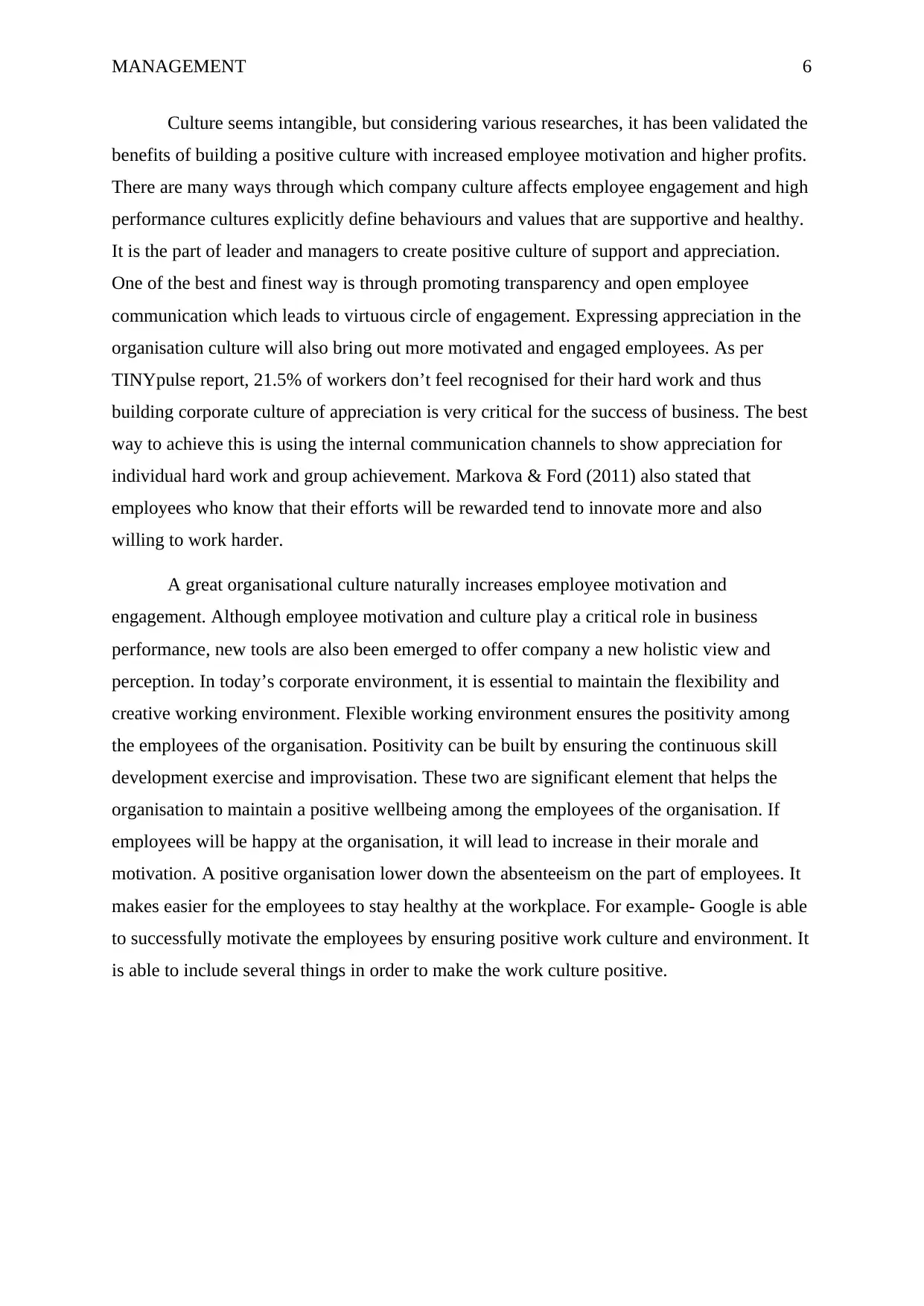
MANAGEMENT 6
Culture seems intangible, but considering various researches, it has been validated the
benefits of building a positive culture with increased employee motivation and higher profits.
There are many ways through which company culture affects employee engagement and high
performance cultures explicitly define behaviours and values that are supportive and healthy.
It is the part of leader and managers to create positive culture of support and appreciation.
One of the best and finest way is through promoting transparency and open employee
communication which leads to virtuous circle of engagement. Expressing appreciation in the
organisation culture will also bring out more motivated and engaged employees. As per
TINYpulse report, 21.5% of workers don’t feel recognised for their hard work and thus
building corporate culture of appreciation is very critical for the success of business. The best
way to achieve this is using the internal communication channels to show appreciation for
individual hard work and group achievement. Markova & Ford (2011) also stated that
employees who know that their efforts will be rewarded tend to innovate more and also
willing to work harder.
A great organisational culture naturally increases employee motivation and
engagement. Although employee motivation and culture play a critical role in business
performance, new tools are also been emerged to offer company a new holistic view and
perception. In today’s corporate environment, it is essential to maintain the flexibility and
creative working environment. Flexible working environment ensures the positivity among
the employees of the organisation. Positivity can be built by ensuring the continuous skill
development exercise and improvisation. These two are significant element that helps the
organisation to maintain a positive wellbeing among the employees of the organisation. If
employees will be happy at the organisation, it will lead to increase in their morale and
motivation. A positive organisation lower down the absenteeism on the part of employees. It
makes easier for the employees to stay healthy at the workplace. For example- Google is able
to successfully motivate the employees by ensuring positive work culture and environment. It
is able to include several things in order to make the work culture positive.
Culture seems intangible, but considering various researches, it has been validated the
benefits of building a positive culture with increased employee motivation and higher profits.
There are many ways through which company culture affects employee engagement and high
performance cultures explicitly define behaviours and values that are supportive and healthy.
It is the part of leader and managers to create positive culture of support and appreciation.
One of the best and finest way is through promoting transparency and open employee
communication which leads to virtuous circle of engagement. Expressing appreciation in the
organisation culture will also bring out more motivated and engaged employees. As per
TINYpulse report, 21.5% of workers don’t feel recognised for their hard work and thus
building corporate culture of appreciation is very critical for the success of business. The best
way to achieve this is using the internal communication channels to show appreciation for
individual hard work and group achievement. Markova & Ford (2011) also stated that
employees who know that their efforts will be rewarded tend to innovate more and also
willing to work harder.
A great organisational culture naturally increases employee motivation and
engagement. Although employee motivation and culture play a critical role in business
performance, new tools are also been emerged to offer company a new holistic view and
perception. In today’s corporate environment, it is essential to maintain the flexibility and
creative working environment. Flexible working environment ensures the positivity among
the employees of the organisation. Positivity can be built by ensuring the continuous skill
development exercise and improvisation. These two are significant element that helps the
organisation to maintain a positive wellbeing among the employees of the organisation. If
employees will be happy at the organisation, it will lead to increase in their morale and
motivation. A positive organisation lower down the absenteeism on the part of employees. It
makes easier for the employees to stay healthy at the workplace. For example- Google is able
to successfully motivate the employees by ensuring positive work culture and environment. It
is able to include several things in order to make the work culture positive.
Paraphrase This Document
Need a fresh take? Get an instant paraphrase of this document with our AI Paraphraser
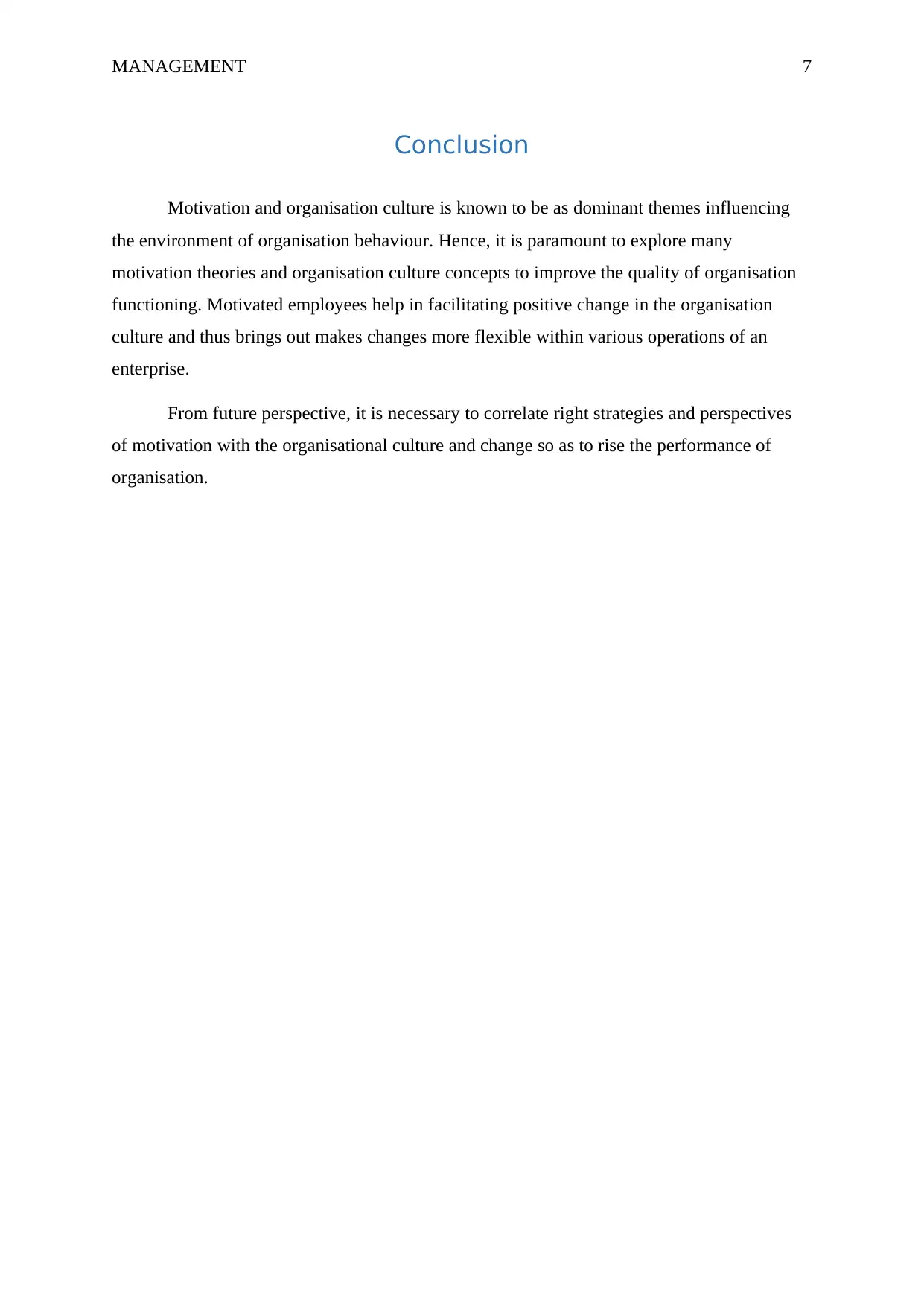
MANAGEMENT 7
Conclusion
Motivation and organisation culture is known to be as dominant themes influencing
the environment of organisation behaviour. Hence, it is paramount to explore many
motivation theories and organisation culture concepts to improve the quality of organisation
functioning. Motivated employees help in facilitating positive change in the organisation
culture and thus brings out makes changes more flexible within various operations of an
enterprise.
From future perspective, it is necessary to correlate right strategies and perspectives
of motivation with the organisational culture and change so as to rise the performance of
organisation.
Conclusion
Motivation and organisation culture is known to be as dominant themes influencing
the environment of organisation behaviour. Hence, it is paramount to explore many
motivation theories and organisation culture concepts to improve the quality of organisation
functioning. Motivated employees help in facilitating positive change in the organisation
culture and thus brings out makes changes more flexible within various operations of an
enterprise.
From future perspective, it is necessary to correlate right strategies and perspectives
of motivation with the organisational culture and change so as to rise the performance of
organisation.
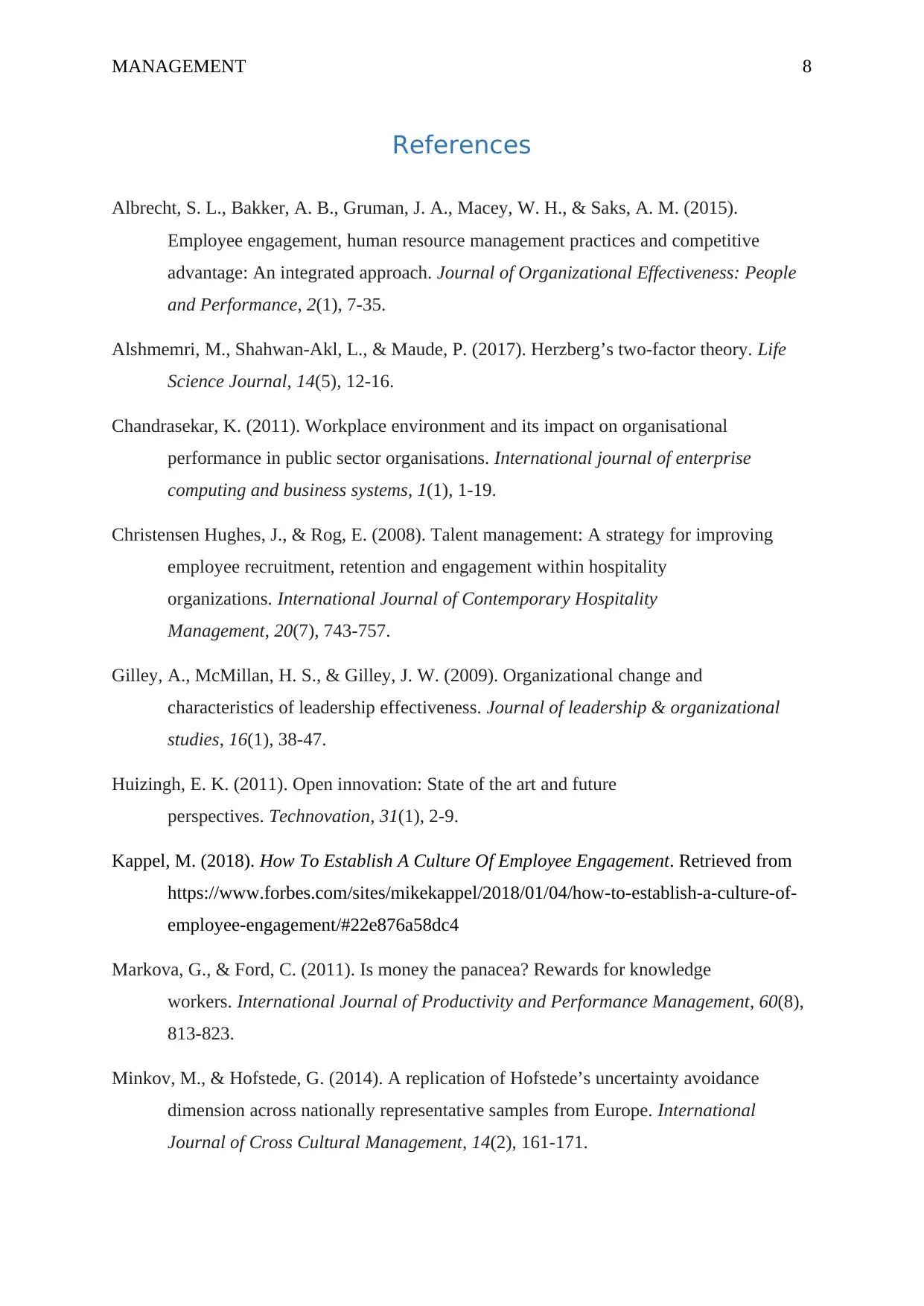
MANAGEMENT 8
References
Albrecht, S. L., Bakker, A. B., Gruman, J. A., Macey, W. H., & Saks, A. M. (2015).
Employee engagement, human resource management practices and competitive
advantage: An integrated approach. Journal of Organizational Effectiveness: People
and Performance, 2(1), 7-35.
Alshmemri, M., Shahwan-Akl, L., & Maude, P. (2017). Herzberg’s two-factor theory. Life
Science Journal, 14(5), 12-16.
Chandrasekar, K. (2011). Workplace environment and its impact on organisational
performance in public sector organisations. International journal of enterprise
computing and business systems, 1(1), 1-19.
Christensen Hughes, J., & Rog, E. (2008). Talent management: A strategy for improving
employee recruitment, retention and engagement within hospitality
organizations. International Journal of Contemporary Hospitality
Management, 20(7), 743-757.
Gilley, A., McMillan, H. S., & Gilley, J. W. (2009). Organizational change and
characteristics of leadership effectiveness. Journal of leadership & organizational
studies, 16(1), 38-47.
Huizingh, E. K. (2011). Open innovation: State of the art and future
perspectives. Technovation, 31(1), 2-9.
Kappel, M. (2018). How To Establish A Culture Of Employee Engagement. Retrieved from
https://www.forbes.com/sites/mikekappel/2018/01/04/how-to-establish-a-culture-of-
employee-engagement/#22e876a58dc4
Markova, G., & Ford, C. (2011). Is money the panacea? Rewards for knowledge
workers. International Journal of Productivity and Performance Management, 60(8),
813-823.
Minkov, M., & Hofstede, G. (2014). A replication of Hofstede’s uncertainty avoidance
dimension across nationally representative samples from Europe. International
Journal of Cross Cultural Management, 14(2), 161-171.
References
Albrecht, S. L., Bakker, A. B., Gruman, J. A., Macey, W. H., & Saks, A. M. (2015).
Employee engagement, human resource management practices and competitive
advantage: An integrated approach. Journal of Organizational Effectiveness: People
and Performance, 2(1), 7-35.
Alshmemri, M., Shahwan-Akl, L., & Maude, P. (2017). Herzberg’s two-factor theory. Life
Science Journal, 14(5), 12-16.
Chandrasekar, K. (2011). Workplace environment and its impact on organisational
performance in public sector organisations. International journal of enterprise
computing and business systems, 1(1), 1-19.
Christensen Hughes, J., & Rog, E. (2008). Talent management: A strategy for improving
employee recruitment, retention and engagement within hospitality
organizations. International Journal of Contemporary Hospitality
Management, 20(7), 743-757.
Gilley, A., McMillan, H. S., & Gilley, J. W. (2009). Organizational change and
characteristics of leadership effectiveness. Journal of leadership & organizational
studies, 16(1), 38-47.
Huizingh, E. K. (2011). Open innovation: State of the art and future
perspectives. Technovation, 31(1), 2-9.
Kappel, M. (2018). How To Establish A Culture Of Employee Engagement. Retrieved from
https://www.forbes.com/sites/mikekappel/2018/01/04/how-to-establish-a-culture-of-
employee-engagement/#22e876a58dc4
Markova, G., & Ford, C. (2011). Is money the panacea? Rewards for knowledge
workers. International Journal of Productivity and Performance Management, 60(8),
813-823.
Minkov, M., & Hofstede, G. (2014). A replication of Hofstede’s uncertainty avoidance
dimension across nationally representative samples from Europe. International
Journal of Cross Cultural Management, 14(2), 161-171.
⊘ This is a preview!⊘
Do you want full access?
Subscribe today to unlock all pages.

Trusted by 1+ million students worldwide
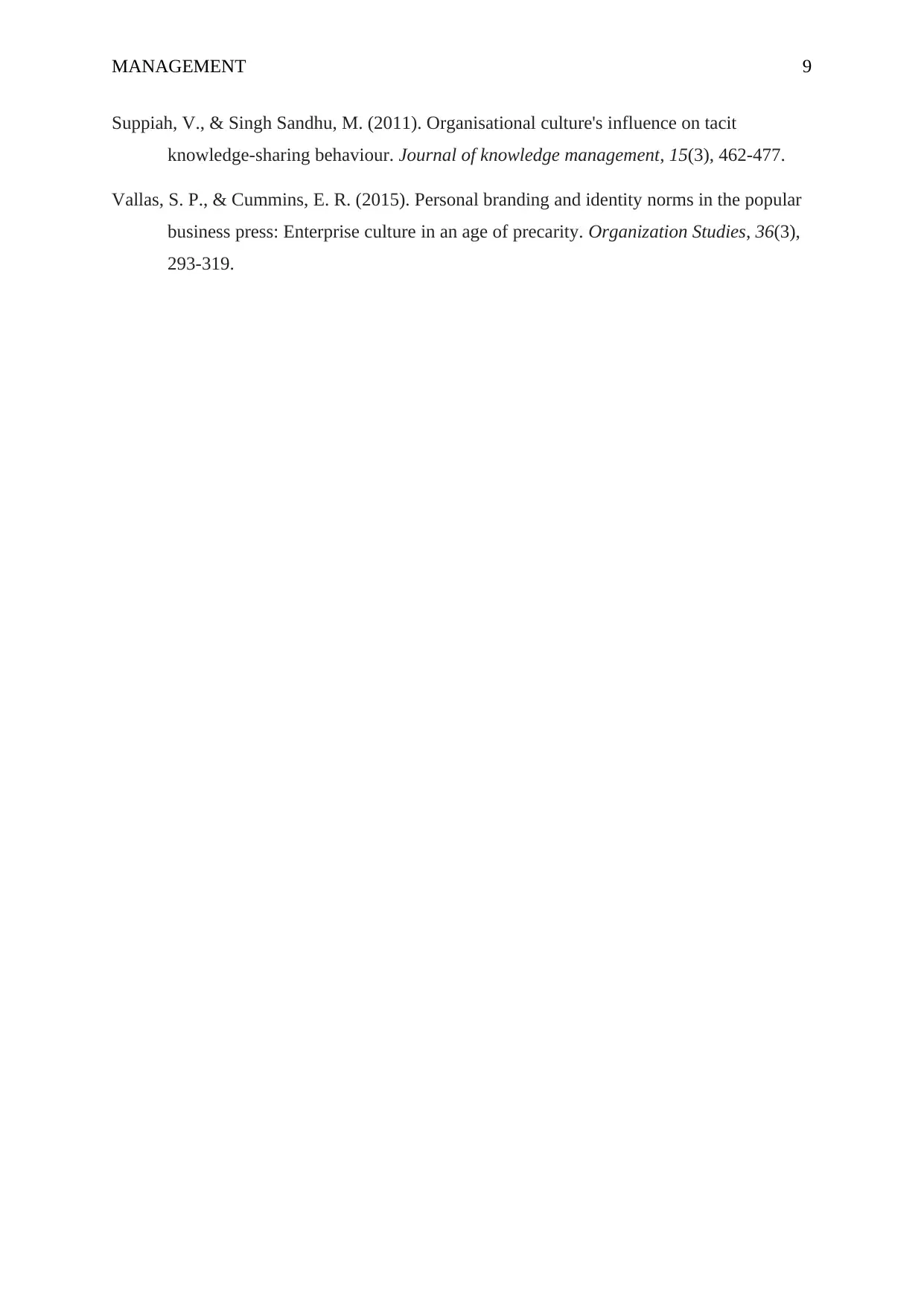
MANAGEMENT 9
Suppiah, V., & Singh Sandhu, M. (2011). Organisational culture's influence on tacit
knowledge-sharing behaviour. Journal of knowledge management, 15(3), 462-477.
Vallas, S. P., & Cummins, E. R. (2015). Personal branding and identity norms in the popular
business press: Enterprise culture in an age of precarity. Organization Studies, 36(3),
293-319.
Suppiah, V., & Singh Sandhu, M. (2011). Organisational culture's influence on tacit
knowledge-sharing behaviour. Journal of knowledge management, 15(3), 462-477.
Vallas, S. P., & Cummins, E. R. (2015). Personal branding and identity norms in the popular
business press: Enterprise culture in an age of precarity. Organization Studies, 36(3),
293-319.
1 out of 10
Related Documents
Your All-in-One AI-Powered Toolkit for Academic Success.
+13062052269
info@desklib.com
Available 24*7 on WhatsApp / Email
![[object Object]](/_next/static/media/star-bottom.7253800d.svg)
Unlock your academic potential
Copyright © 2020–2025 A2Z Services. All Rights Reserved. Developed and managed by ZUCOL.





